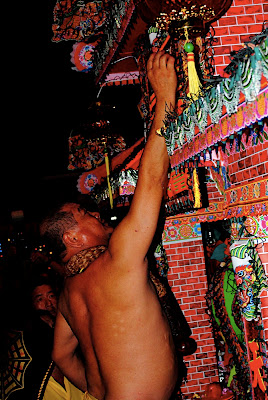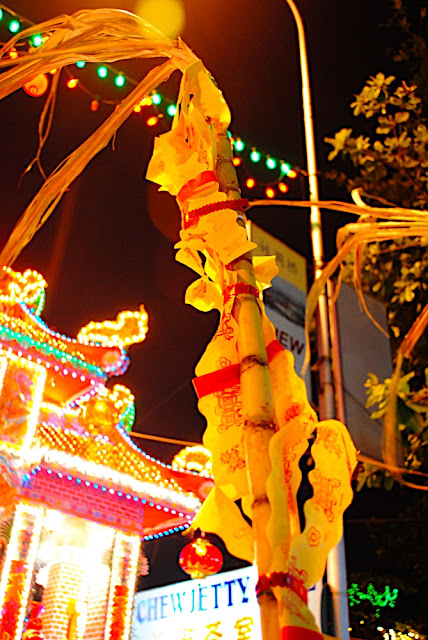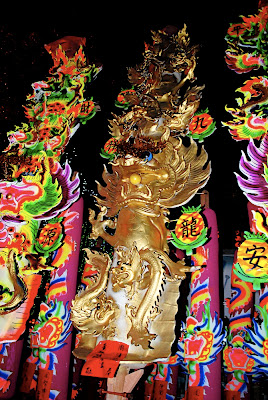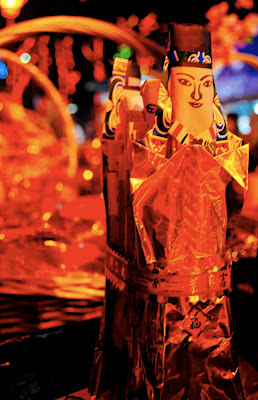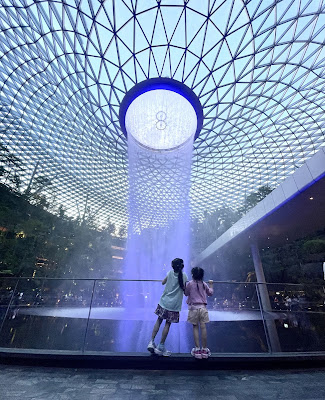Hokkien New Year at Chew Jetty, Penang
Chinese New Year is a celebration of the the first day of the lunar calendar, and lasts for 15 days. However, for the Hokkien community in Penang, the 9th day of Chinese New Year is also another celebration of the new year. Penang has a large Hokkien community, whose ancestors were immigrants primarily from Fujian province in China.
The Hokkien New Year is to celebrate the day when the Hokkiens escaped mistreatment by ruthless army in ancient China by seeking refuge in a sugarcane plantations. The Hokkiens emerged unharmed on the 9th day of Chinese New Year, and it was then considered as new year for the Hokkiens.
The 9th day of Chinese New Year also coincides with the birthday of the Jade Emperor of Heaven (Thni Kong Seh). The Hokkien community in Penang celebrates Thni Kong Seh around midnight on the eighth day, by praying to the Jade Emperor of Heaven (or Thni Kong). While most homes would have their own celebration and prayers, the largest celebration was in Chew Jetty.
As I wrote in my previous post, the clan houses of Penang, clan houses and associations are an important aspect of the Penang Chinese community. There is also a whole stretch of clan jetties named after the surnames of the residents there in Weld Quay. The clan jetties are villages built on stilts with rows of houses connected by wooden walkways. The Chew Jetty is one of the few surviving clan jetties. It was built more than a century ago by the Chinese immigrants with the surname Chew. Today, Chew Jetty remained a village for more than a thousand residents.
The Chew Jetty has one of the biggest community Thni Kong Seh celebration in Penang. The celebration was held on the eighth day of the Chinese New Year which fell on 21 February this year, and started from around 8pm to midnight. Tables are joined to make a long row just outside of Chew Jetty, with an altar in front (below).
Residents of Chew Jetty would bring out offerings for the Jade Emperor of Heaven (Thni Kong) and leave them on the table.
Offerings would include buns in the shape of turtle (below), roast pork (further below), fruits and tea.
The Hokkien New Year is to celebrate the day when the Hokkiens escaped mistreatment by ruthless army in ancient China by seeking refuge in a sugarcane plantations. The Hokkiens emerged unharmed on the 9th day of Chinese New Year, and it was then considered as new year for the Hokkiens.
The 9th day of Chinese New Year also coincides with the birthday of the Jade Emperor of Heaven (Thni Kong Seh). The Hokkien community in Penang celebrates Thni Kong Seh around midnight on the eighth day, by praying to the Jade Emperor of Heaven (or Thni Kong). While most homes would have their own celebration and prayers, the largest celebration was in Chew Jetty.
As I wrote in my previous post, the clan houses of Penang, clan houses and associations are an important aspect of the Penang Chinese community. There is also a whole stretch of clan jetties named after the surnames of the residents there in Weld Quay. The clan jetties are villages built on stilts with rows of houses connected by wooden walkways. The Chew Jetty is one of the few surviving clan jetties. It was built more than a century ago by the Chinese immigrants with the surname Chew. Today, Chew Jetty remained a village for more than a thousand residents.
[Photo taken from the Chew Jetty]
The Chew Jetty has one of the biggest community Thni Kong Seh celebration in Penang. The celebration was held on the eighth day of the Chinese New Year which fell on 21 February this year, and started from around 8pm to midnight. Tables are joined to make a long row just outside of Chew Jetty, with an altar in front (below).
Residents of Chew Jetty would bring out offerings for the Jade Emperor of Heaven (Thni Kong) and leave them on the table.
Offerings would include buns in the shape of turtle (below), roast pork (further below), fruits and tea.
[This photo was taken in the temple inside the Chew Jetty]
As the Hokkiens escaped by hiding in sugarcane plantation, sugar canes are also an important offering.
Candles in the shape of lotus (below), large incense (further below in shapes of dragons) and gold paper would also be burned.
However, I did not stay till midnight when the prayers and burning would begin as I had to be home and pray to Thni Kong at home. While I am not Hokkien, it has became such a cultural event in Penang that we do it every year too.
